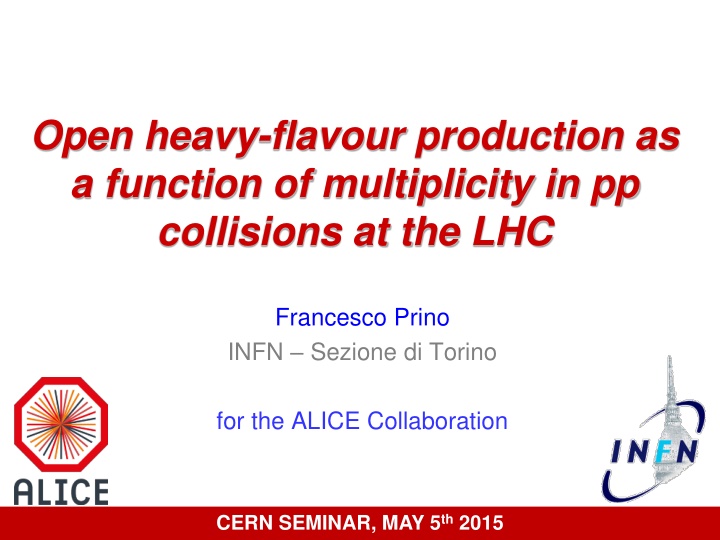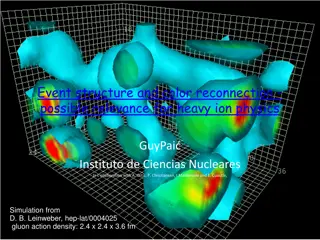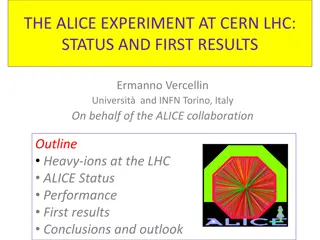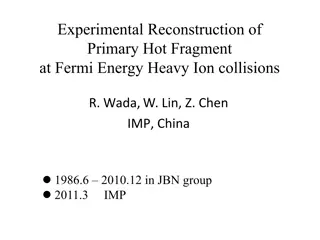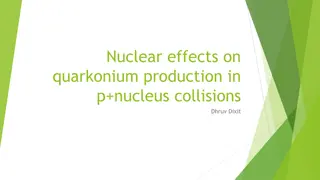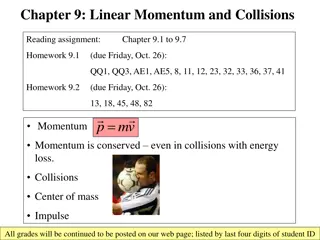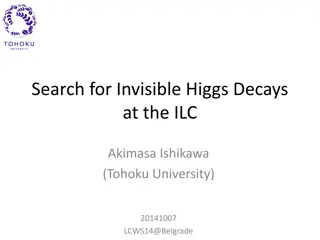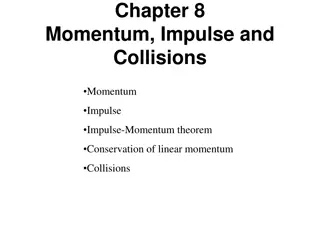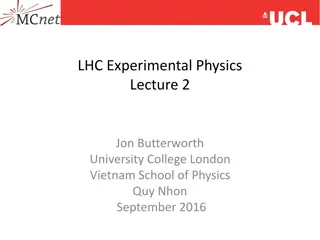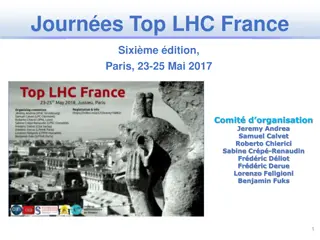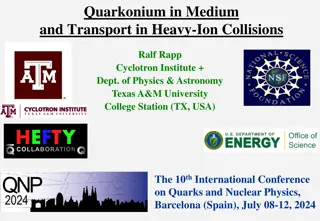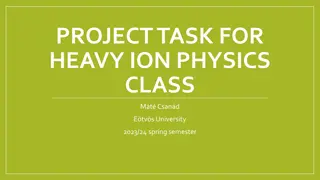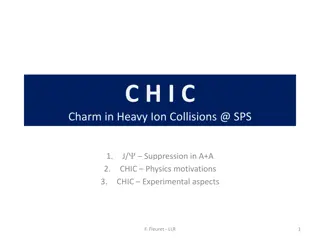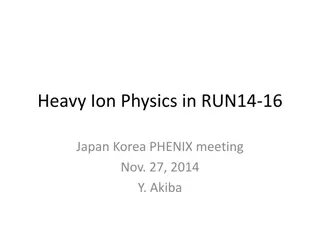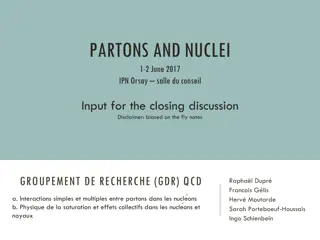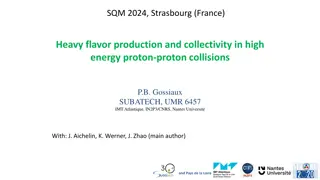Open Heavy-Flavour Production in pp Collisions at the LHC - Physics Seminar Overview
Physics seminar presentation by Francesco Prino on open heavy-flavour production as a function of multiplicity in pp collisions at the Large Hadron Collider (LHC). The talk covers the motivation behind studying heavy-flavour production mechanisms, data analysis techniques, results on the multiplicity dependence, comparison with model calculations and event generators, and conclusions drawn from the analysis. Various topics discussed include heavy quark production, open charm and beauty measurements at the LHC, and cross-section calculations using perturbative QCD calculations.
Download Presentation

Please find below an Image/Link to download the presentation.
The content on the website is provided AS IS for your information and personal use only. It may not be sold, licensed, or shared on other websites without obtaining consent from the author.If you encounter any issues during the download, it is possible that the publisher has removed the file from their server.
You are allowed to download the files provided on this website for personal or commercial use, subject to the condition that they are used lawfully. All files are the property of their respective owners.
The content on the website is provided AS IS for your information and personal use only. It may not be sold, licensed, or shared on other websites without obtaining consent from the author.
E N D
Presentation Transcript
Open heavy-flavour production as a function of multiplicity in pp collisions at the LHC Francesco Prino INFN Sezione di Torino for the ALICE Collaboration CERN SEMINAR, MAY 5th 2015
Outline Physics motivation Heavy-flavour production mechanisms in pp collisions Interplay between hard and soft processes of particle production Multi-Parton Interactions (MPI) Data analysis Multiplicity estimation D-meson reconstruction J/ from B-hadron decays Results Multiplicity dependence of open heavy-flavour production in pp collisions Comparison between open charm, open beauty and charmonia Comparison to model calculations PYTHIA, EPOS event generators Calculations with the percolation model Comparison to results in p-Pb collisions Conclusions 2
Heavy flavours in pp collisions Heavy quarks (charm and beauty) produced in partonic scattering processes with large Q2 Production cross section can be calculated with perturbative QCD calculations based on the factorization approach D c = 2 2 2 ( , ) ( , ) , PDF x Q PDF x Q D (z Q ) hh Hx a b ab q q q H q Kniehl et al., PRD 71 (2005) 014018 Jung et al., JHEP 1101 (2011) 085 Mangano et al., Nucl. Phys. B373 (1992) 295 Cacciari et al., JHEP 05 (1998) 007 4
Open charm in pp collisions Measurements at the LHC described by pQCD calculations within uncertainties FONLL Cacciari et al., JHEP 1210 (2012) 137 D0 GM-VFNS Kniehl et al., EPJ C72 (2012) 2082 LO kT-factorization Maciula, Szczurek, PRD 87 (2013) 094022 Ds+ D+ ALICE, JHEP 1201 (2012) 128 ALICE, PLB 718 (2012) 279 LHCb, Nucl.Phys. B871 (2013) 1 5
Open beauty in pp collisions Measurements at the LHC described by pQCD calculations within uncertainties FONLL Cacciari et al., JHEP 1210 (2012) 137 GM-VFNS Kniehl et al., EPJ C72 (2012) 2082 LO kT-factorization Maciula, Szczurek, PRD 87 (2013) 094022 B0, B+ Cacciari et al., JHEP 1210 (2012) 137 CMS, PRL 106 (2011) 112001 CMS, PRL 106 (2011) 252001 J/ B ALICE, JHEP 1211 (2012) 065 CMS, EPJ C71 (2011) 1575 LHCb, EPJ C71 (2011) 1645 6
Heavy-flavour cross section b b b b at at midrapidity midrapidity c c c c at at midrapidity midrapidity ALICE, PLB 738 (2014) 97 ALICE, JHEP 1207 (2012) 191 Total charm and beauty production cross section described by pQCD calculations within uncertainties Charm on the upper edge of the theoretical uncertainty band at all collision energies 7
Hard scattering and underlying event Two component approach: Hard scattering process Large Q2, perturbative QCD Dijet Initial/Final state radiation Underlying event (UE) = final state particles not associated to the hard scattering (perturbative) (mini)jets produced in softer multi-parton interactions (MPI) Soft hadronic processes Fragmentation of beam remnants 8
More differential measurements More differential measurements deeper insight into charm production in pp collisions D-hadron angular correlations Charm quark fragmentation c c production mechanism Charm and beauty hadron production as a function of the multiplicity of charged particles produced in the collision Interplay between hard and soft processes Multi-Parton Interactions FOCUS OF TODAY S SEMINAR ALICE, arXiv:1505.00664 9
Charm production vs. multiplicity NA27 and LEBC-EHS Collaboration pp collisions at SPS pBEAM = 400 GeV Different multiplicity distributions for events with and without charm production It is natural to interpret these differences by the more central nature of collisions leading to charm production. Aguilar-Benitez et al., Z. Phys C41 (1988) 191 10
J/ production vs. multiplicity ALICE, PLB 712 (2012) 165 Self-normalized quantities Some uncertainties cancel out Compare different experiments / systems / energies Per-event J/ yield increases approximately linearly with multiplicity Hadronic activity accompanying J/ production? Multi-Parton interactions? LHCb, PLB 707 (2012) 52 LHCb, JHEP 06 (2012) 141 11
J/ production vs. multiplicity ALICE, PLB 712 (2012) 165 Hard process yield Charged particle multiplicity Dominated by soft processes ? Coincides with KNO scaling variable Koba, Nielsen, Olesen, Nucl.Phys. B40 (1972) 317 Per-event J/ yield increases approximately linearly with multiplicity Hadronic activity accompanying J/ production? Multi-Parton interactions? LHCb, PLB 707 (2012) 52 LHCb, JHEP 06 (2012) 141 12
Multi Parton Interactions Na ve picture Several interactions at the partonic level occur in parallel At LHC energies: cross section for 2-2 parton scatterings with Q2 ~ few GeV/c exceed the total hadronic cross section Bartalini, Fano, arXiv:1003.4220 Yield of particles from hard processes should increase with multiplicity More complex picture Role of collision geometry (impact parameter + transverse structure of proton) Frankfurt, Strikman, Weiss, PRD 83 (2011) 054012 Azarkin, Dremin, Strikman, PLB 735 (2014) 244 Final state: color reconnections, saturation, string percolation Ferreiro, Pajares, PRC 86 (2012) 034903 Collectivity in pp for sufficiently high multiplicities? Multiplicities in high multiplcity pp collisions at the LHC similar to peripheral Cu-Cu at RHIC Werner et al., PRC 83 (2011) 044915 13
How to gain more insight? Extend to open charm (D mesons) Compare open/hidden charm production Study yield of D mesons vs. multiplicity in pT intervals Extend to open beauty production Via non-prompt J/ Extend to higher multiplicities Clearer picture of the trend. Linear? Stronger than linear? ALICE, PLB 712 (2012) 165 14
(Selection of) other studies as a function of multiplicity in pp collisions at the LHC 15
Bottomonia vs. multiplicity (nS) production ratios depend on multiplicity Ground state (1S) systematically produced with more particles? Excited states more easily dissociated by interactions with other particles? Yield of increases with multiplicity Similar in pp, p-Pb and Pb-Pb In Pb-Pb (and p-Pb) number of nucleon-nucleon collisions increases with multiplicity CMS, JHEP 1404 (2014) 103 16
Jets and UE vs. multiplicity High-multiplicity events: Larger number of (semi) hard parton interactions, (mini)jets Softer distribution of hadrons inside jets Multi-Parton Interaction (MPI) mechanism critical to reproduce the features of the data 17 CMS, EPJ C73 (2013) 2674
Mini jets in pp vs. multiplicity Mini jets: bundles of particles from semi-hard partonic scatterings How: from 2-particle correlations, associated yields in near and away sides ALICE, JHEP 09 (2013) 049 Near side associated yield Away side associated yield 18
Mini-jets in pp vs. multiplicity Mini-jets: bundles of particles from semi-hard partonic scatterings How: from 2-particle correlations, associated yields in near and away sides ALICE, JHEP 09 (2013) 049 Uncorrelated seeds = number of independent sources of particle production N trigger = N uncorrelat ed seeds + 1 N +away assoc , near In PYTHIA strongly correlated with number of MPIs Linearly increasing with multiplicity at low multiplicity Levels off at high multiplicities 19
Angular correlations: pp collisions, high multiplicity CMS, JHEP 1009 (2010) 091 High-multiplicity pp events 8x average multiplicity -> near side ridge along : origin? Jet peak Recoil jet on the away side Ridge in Pb-Pb collisions described by hydrodynamics Initial state geometrical anisotropy + collective expansion Also observed in high multiplicity p-Pb collisions at the LHC CMS, PLB 718 (2013) 795 ALICE, PLB 719 (2013) 29 20
Heavy-flavour vs. multiplicity: Data analysis 21
ALICE at the LHC Muon Arm -4 < < -2.5 Central Barrel Tracking, PID < 0.9 22
Data sample pp collisions at s = 7 TeV Minimum-bias trigger Signal in V0A or V0C or SPD N. events = 314 106 Ldt = 5 nb-1 High-multiplicity trigger Threshold on number of fired chips in SPD N. events = 6 106 Ldt = 14 nb-1 SPD | <1.4 SPD | <1.4 V0C V0A -3.7< <-1.7 2.0< <5.1 23
Multiplicity estimation Number of tracklets in the two innermost ITS layers Silicon Pixel Detectors, pseudo-rapidity range: | |<1.0 Ntracklets dNch/d Sum of amplitudes in the V0 scintillator arrays NV0, pseudo-rapidity range -3.7< <-1.7 and 2.8< <5.1 ALICE, PLB 712 (2012) 165 24
Ntracklets intervals Number of tracklets in the two innermost ITS layers Silicon Pixel Detectors, pseudo-rapidity range: | |<1.0 Ntracklets dNch/d MB trigger High Mult trigger 25
Open charm 26
D-meson reconstruction Full reconstruction of D-meson K hadronic decays D0 K- + D+ K- + + D*+ D0 + Ds+ K-K+ + Analysis strategy Invariant mass analysis of fully reconstructed decay topologies displaced from the primary vertex Background reduction via: Geometrical selections on the decay vertex Particle identification of the decay products Feed down from B (10-15 % after cuts) subtracted using pQCD (FONLL) predictions 27
D-meson reconstruction Full reconstruction of D-meson K hadronic decays D0 K- + D+ K- + + D*+ D0 + Ds+ K-K+ + Geometrical selections Track impact parameter (resolution 75 m at pT = 1 GeV/c) Decay length Pointing of the D-meson momentum to the primary vertex ALICE, JHEP 1201 (2012) 128 28
D-meson reconstruction Full reconstruction of D-meson K hadronic decays D0 K- + D+ K- + + D*+ D0 + Ds+ K-K+ + PID selection: 3 cuts on dE/dx in TPC Time-of-flight from interaction point to TOF detector 29
D0, D+, D*+ invariant mass Low multiplicity Mid multiplicity High multiplicity D0 Low pT D+ Mid pT D*+ High pT 30 ALICE, arXiv:1505.00664
Corrections and systematics D-meson yield / event in multiplicity intervals corrected for reconstruction efficiency mult raw mult D N mult event /( ) N N 2 D / d N dydp D = T trigger tot raw tot D tot event 2 D /( / ) N / d N dydp D T D-meson yield / event multiplicity integrated, corrected for reconstruction and trigger efficiencies Sources of systematics Raw yield extraction D-meson line shape Background fit function 3-15% depending on pT, multiplicity, species Primary vertex determination With/without D-meson decay tracks Negligible effect Selection and PID efficiency Same selection used in all multiplicity intervals Negligible residual effect due to multiplicity dependence of efficiency Fraction of prompt D mesons in the raw yield Assumed to be the same in all multiplicity bins (cancels out in the ratio) Uncertainty by varying the D B contribution by a factor 1/2 (2) at low(high) multiplicity 31
Corrections and systematics D-meson yield / event in multiplicity intervals corrected for reconstruction efficiency mult raw mult D N mult event /( ) N N 2 D / d N dydp D = T trigger tot raw tot D tot event 2 D /( / ) N / d N dydp D T D-meson yield / event multiplicity integrated, corrected for reconstruction and trigger efficiencies Contribution of D from B decays: assumed independent of multiplicity uncertainty by varying the D B contribution by a factor 1/2 (2) at low(high) multiplicity 32 ALICE, arXiv:1505.00664
D0, D+, D*+ yield vs. multiplicity 2<pT<4 GeV/c 4<pT<8 GeV/c 8<pT<12 GeV/c D0 D+ D*+ D-meson per-event yields increase with charged-particle multiplicity Similar trend in different pT intervals Faster than linear increase D0, D+ and D*+ results compatible within uncertainties Compute the average of the three meson species 33 ALICE, arXiv:1505.00664
D-meson yield vs. multiplicity pT dependence? Trend of D-meson yield vs. multiplicity independent of pT within uncertainties 34 ALICE, arXiv:1505.00664
Introducing an gap Charged-particle multiplicity measured in the same range as D mesons Multiplicity estimation includes: D-meson decay particles Particles produced in the charm-quark fragmentation Test effect of possible auto- correlations using the multiplicity measured in the V0 detector Qualitatively similar increasing trend when an gap is introduced between the regions in which D mesons and multiplicity are measured V0C V0A -3.7< <-1.7 2.0< <5.1 35 ALICE, arXiv:1505.00664
J/ from beauty-hadron decays 36
J/ from beauty-hadron decays Displaced J/ (from beauty- hadron decays) J/ e- e+ e+ e- B ? ALICE, PRD 86 (2012) 112007 Analysis strategy Electron identification based on energy loss in TPC 3 cut around expected e dE/dx 3.5 (3 ) exclusion band around expected (p) dE/dx 37
J/ from beauty-hadron decays Displaced J/ (from beauty- hadron decays) J/ e- e+ e+ e- B ? Analysis strategy Electron identification based on energy loss in TPC Reduction of background from conversions and 0 Dalitz decays Excluding e that form e+e- pairs with invariant mass < 100 MeV/c2 38
J/ from beauty-hadron decays Displaced J/ (from beauty- hadron decays) J/ e- e+ e+ e- B ? M c Analysis strategy Electron identification based on energy loss in TPC Reduction of background from conversions and 0 Dalitz decays J/ production vertex reconstruction Simultaneous fit to invariant mass and pseudo-proper decay length (x) distributions J/ p = x L xy J/ T J/ p = L L T xy J/ p T 39
Non-prompt J/ : fits Fraction of non-prompt J/ from 2D un-binned log- likelihood fit to: Invariant mass M(e+e-) Pseudo- proper decay length x Increasing multiplicity M c J/ p = x L xy J/ T 40 ALICE, arXiv:1505.00664
Corrections and systematics Fraction of reconstructed non-prompt J/ Raw value f B extracted from 2D un-binned log-likelihood fits Corrected for acceptance x efficiency N f raw J/ + B N = B raw J/ raw J/ N prompt B 3% difference between Ax of prompt and non-prompt J/ Extrapolation from pT>1.3 GeV/c to pT>0 Extrapolation factor: extr = 0.99 +0.01 0.03 Based on FONLL (non-prompt) and phenomenological (prompt) pT shapes NOTE: pT>1.3 GeV/c selection needed because of the non- negligible amount of J/ emitted with large opening angle with respect to the beauty-hadron direction at low pT 41
Corrections and systematics Sources of systematic uncertainty Primary vertex determination With/without removing J/ decay tracks (resolution and bias) Effect: 19% at low multiplicity 3% at high multiplicity Resolution of pseudo-proper decay length (x) Due to imperfect description of x variable in the simulations Effect: 8% at low multiplicity 20% at high multiplicity Generated J/ pT distributions in MC Effect on Ax (~ 1%) Effect on x resolution (within the estimated uncertainty) Modeling of J/ from beauty pseudo-proper decay-length distribution Beauty-hadron decay kinematics and pT spectra Effect: 3%, independent of multiplicity Background modeling in the fit Use side-bands for x distributions Use LS to check the invariant mass distribution Effect: ~7% , independent of multiplicity Extrapolation to pT=0 Effect: 3% 42
Fraction of non-prompt J/ Fraction of non-prompt J/ Approximately flat as a function of multiplicity Non-prompt J/ yield relative to the multiplicity integrated one computed as: ALICE, arXiv:1505.00664 Inclusive J/ result from: ALICE, PLB 712 (2012) 165 Multiplicity integrated value <fB> 43
Open charm, charmonia and open beauty 44
D mesons vs. inclusive J/ Similar increase with multiplicity of per-event yield of open and hidden charm Inclusive J/ measured at mid (e+e-) and forward ( + -) rapidity Forward rapidity J/ and charged multiplicity measured in different regions D mesons, mid y J , mid y J , forward y ALICE, arXiv:1505.00664 Inclusive J/ result from: ALICE, PLB 712 (2012) 165 45
Open charm vs. open beauty Similar increase with multiplicity of per-event yield of open charm and beauty production D mesons, mid y J beauty, mid y ALICE, arXiv:1505.00664 46
Comparison to model calculations 47
Model calculations ALICE, arXiv:1505.00664 Percolation model Elementary sources of particle production: colour ropes/strings formed in parton-parton collisions Close to MPI scenario Colour strings have finite spatial extension and interact At high densities: overlap among the sources -> reduction of their number Affects more soft sources (larger transverse size) and charged multiplicity More than linear increase of D-meson yield with multiplicity 48 Ferreiro, Pajares, PRC 86 (2012) 034903
Model calculations ALICE, arXiv:1505.00664 EPOS 3.099 Initial conditions Gribov-Regge multiple-scattering formalism Saturation scale to model non-linear effects Hadronization via string fragmentation Number of MPI directly related to multiplicity Hydrodynamical evolution Can be applied to the dense core of the collision Results in a stronger than linear increase of D-meson yield with multiplicity 49 Werner et al., PRC 89 (2014) 064903
Model calculations ALICE, arXiv:1505.00664 PYTHIA 8 Soft-QCD tune Colour reconnections Multi-parton interactions Initial and Final state radiation (ISR/FSR) Almost linear increase of D-meson yield with multiplicity Trend depends on pT 50
